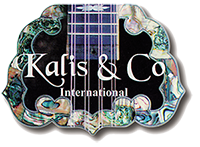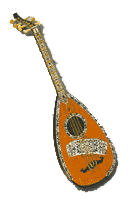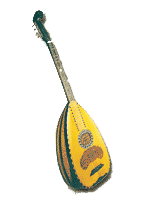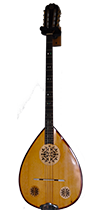 The name “tambouras” has been used by the Greeks in reference to a series of stringed musical instruments resembling the “bouzouki”, regardless of size, number of strings, fret distribution/positioning or tuning. This series of instruments belonged to the Tamboura family based on the following similarities:
The name “tambouras” has been used by the Greeks in reference to a series of stringed musical instruments resembling the “bouzouki”, regardless of size, number of strings, fret distribution/positioning or tuning. This series of instruments belonged to the Tamboura family based on the following similarities:
- Small sound-box usually is the shape of a pear
- A thin long neck straight from one end to the other
- Usually with Frets that were originally movable (adjustable) which are in modern days fitted on the fret board permanently
- Pegs (Klidia) which were originally made of hard wood, (ebony) and were fitted similarly to those of the violin family, and have now been replaced by the commercially made machine heads
- A number of strings which are supported by a bridge “kavalaris”
- They were played “Plucked” with a plectrum “Penna” or sometimes with the players finger nails

Furthermore, prisoners were using small dry gourds or other similar types of materials such as carved sound box to make small size baglama, which they would conceal on them and smuggle in their jail cells. These instruments were also known as “Gonato” which means “The knee” because they would fasten it on to their knee when they were entering the jail in such a way that the guards would not be able to detect them.
The soundboard was made from animal hide stretched over the box in the older days and later out of wood, such as spruce.
Instruments of the Tamboura family were played in the older days as single instruments without being accompanied by other rhythmic instruments. The musician would play the tune on the first string being of higher pitch, which is also known as the “Kandini” and at the same time would use the other strings open usually wound and known as Mourganes or Mbourganes to produce isotonic, tonic or 5th sound etc.
This was always analogous to the number of strings and the tuning. In time this method of playing has progressed to what we know today, with the harmonic accompaniment based on a specific scale.
Instruments of the Tamboura family, with long thin neck and a small round sound box were present in Greece since about the 4th century BC. In those days these instruments were known as “PANDOURA”. This is firmly documented by various painting and mosaics from that epoch, depicting a musician playing the Pandoura with a plectrum or penna. More evidence of their existence could be found in later years of the 10th, 12th, 16th, 18th and 20th centuries by official letters, memos and reports written by various scholars and notable personalities of those years. For example, a respectable author by the name of Constantine Porfirogenitos had made mention in one of his reports, of Pandouras and Pandourists (The Player) being present at a high profile dinner in the 10th century, where another writer had made mention of Tambouras and other instruments entertaining high caliper invited guests of a gala event at the Constantinople Race Track in the 12th century.
LAUTO
The Lauto, also known as lavouto or lagouto, has been named as such from the Arabic word “OUD” which means wood. This instrument or a variation thereof is also known as “Lute” which was very prominent during the renaissance and baroque eras. It is worth noting at this point that an instrument maker is called a “LUTHIER” which is a derivative of the word LUTE. The sound box of the Greek Lauto is unusually large in relation to other instruments of the Tamboura family, such as the bouzouki. Saz etc.
 It usually has movable/adjustable frets, 8 strings and a bridge glued permanently to the soundboard and it is played with a plectrum. In the older days players would use plectrums made from tortoise shell, or even feathers of larger foul such as wild turkey etc.
It usually has movable/adjustable frets, 8 strings and a bridge glued permanently to the soundboard and it is played with a plectrum. In the older days players would use plectrums made from tortoise shell, or even feathers of larger foul such as wild turkey etc.
The Bouzouki has not changed much in the very many years of its existence. Throughout the epoch however, it has evolved from a six-string instrument to an eight-string instrument that is most popular with Bouzouki players of today, and the playing style and technique have also been amended to reflect today’s sounds and musical expectation. The Bouzouki has been persecuted by the authorities in the past century and part of this century as they had associated it to the criminal society of Greece, (unfairly and wrongly). It is purely a “sole” instrument and even though various qualified teachers have written many books it may never be learned by just anyone. By this statement I mean that even though everyone may have the ability with proper training, to make music with a Bouzouki, few of us posses the ability to be able to perform with it and to relay through the instrument our most inner feelings, thoughts, and emotions, which change from moment to moment. In a nutshell it is the “mirror” of our soul. Other similar instruments belonging to the Bouzouki family are, Tzouras, Baglamas, Bouzoukomana, and Gonato that can be distinguished from each other by their means of construction, size, shape, number of strings, etc. The most common length for a normal Bouzouki is 70cm, in the older days it would resemble a pear-shape and was somewhat smaller. In modern days however it is made larger and resembles a large version of a Mandolin. It has a long neck with frets and sounds somewhat like a Mandolin or Lute. The smallest instrument of this family is the Baglamas, which is about 30-35cm long, and mostly with 6 strings (3 Doubles). Bouzouki – Technique & Tuning












